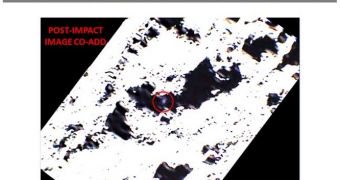In October, NASA deliberately crashed its Lunar CRater Observing and Sensing Satellite (LCROSS) experiment on the south pole of the Moon, creating two impact craters. One of them was caused by the spent Centaurus rocket stage that the LCROSS instrument was carrying, while the second was made by the $79 million spacecraft itself, as it fell to its demise while snapping photos of the Centaurus impact site. Scientists are still analyzing the data that was sent back by the probe, but not everybody is happy about the new experiment, Space reports.
The LCROSS flight and impact were devised in such a way that the Centaurus stage would kick up a massive plume of debris high into the lunar atmosphere, which would enable spectrometers to search for the specific wavelength signature of water-ice. The resource would make all the difference in the world for a future lunar mission, as astronauts would have water on site, and not have to carry it with them from Earth. Final results on whether the stuff was discovered are still pending, NASA says.
However, not everyone took the impacts lightly. The new mission has spawned massive controversies on the Internet, with several groups and associations speaking out against this type of experiments. Screenwriter Amy Ephron even set up a Twitter page called “Help Save the Moon," which she plans to use for preventing NASA from attempting similar flights in the future. “Well, I for one, don't like explosions. Call me a pacifist, call me cautious, call me an environmentalist, or call me something worse, I don't really care,” Ephron states.
Jennifer Heldmann, a NASA representative, highlighted the fact that LCROSS would not be doing anything out of the ordinary. Before the mission, she explained that the spacecraft would have the same impact on the Moon as a very long series of small celestial bodies that hit the Earth's natural satellite constantly. The scientist, who is also the LCROSS Observation Campaign leader, added that the cratery appearance of the Moon is given by precisely impacts such as this one. “On LCROSS there are no explosives, there's no bomb. So we're not bombing the Moon,” she added.
There are even those who say that NASA used the mission to destroy alien moon bases, or to instill damage on the satellite that would prevent high tides, or even to quench NASA engineers' appetite for explosions. All of these seem at least far-fetched. Any self-respecting conspiracy theorist knows that the alien bases are on the far side of the Moon, and not in the Cabeus Crater, which can be seen from the Earth with a good telescope.
“There are real issues related to lunar preservation and silly issues. The concern about LCROSS is in the latter category. A small crater in a crater saturated surface is hardly environmental destruction,” said NASA Ames Research Center space scientist Chris McKay.
“Whether you agree or disagree with the protests about the LCROSS mission, it shows that the moon is perceived as a cultural place as well as a celestial body orbiting Earth. The moon is seen as part of both a cultural and natural landscape that may be harmed,” counters New Mexico State University Department of Sociology and Anthropology expert Beth Laura O'Leary from Las Cruces.
“The idea of sending a spacecraft – robotic or human piloted – to the moon was viewed in the 1950s and 1960s as a legitimate scientific exploration, although it was firmly set in the context of the Cold War. The sentiment (...) is that it is a bomb site not a crash site and that with the LCROSS mission we are disturbing the natural order of the universe – from changing the tides to committing a sacrilege. Some feel it is a violation of the United Nations Outer Space Treaty,” she concludes.

 14 DAY TRIAL //
14 DAY TRIAL //